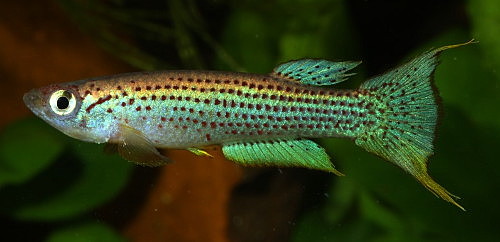Fenerbache devosi Sonnenberg R., Woeltjes T. & J. van der Zee 2011

Photo courtesy of Heinz Ott.
| Meaning of Name |
Fenerbache is Turkish in origin & shares it's name with a Turkish football team - Fenerbache Istanbul. After Luc De Vos, head of the Ichthyology department of the National Museums of Kenya, who passed away in 2003. He made many collections in the Congo drainage including this sp. |
||
| First Description |
Sonnenberg R., Woeltjes T. & J. van der Zee - 2011 Description of Fenerbahce devosi (Cyprinodontiformes: Nothobranchiidae), A new species of dwarf killifish from the eastern Congo Basin in the Democratic Republic of Congo. Zootaxa 2966: 1–12 (2011) |
||
| Size |
Holotype male - 23·6 mm. Females used in the description were 14·9–18·4 mm. Males have been recorded at 38 mm in the aquarium. |
||
| Meristics | D= 8-9, A= 14-16, D/A= 1/8-9. | ||
| Karyotype | |||
| Sub-Genus | |||
| Group | |||
| Synonyms |
|
||
|
Populations
|
AVD 2007 / 1 - Located 7 kms north of Ubundu. Sympatric sp. A.musafirii.
AVD 2007 / 2 - Located 67 kms south of the ferry across the Congo on road R410 to Ubundu. Sympatric sp. A.musafirii.
|
||
| Type Locality |
Located 67 km south from the ferry across the
Congo River at Kisangani, towards Ubundu on road R410, Ruiki River drainage,
collection |
||
| Distribution |
Near Ubundu. Along the Congo River both sides of Kisangani. Those collected up river were called F.devosi whilst those collected down river were called F.sp.aff.devosi. |
||
| Habitat |
Small brooks & rivers off the Congo River. |
||
| Distinguishing Characteristics |
A more anterior dorsal fin relative to the anal.
Long extensions to caudal fin. Different colouration to F.formosus.
F.devosi is a larger sp. than formosus
(38 mm verses 30 mm). |
||
| Colour/Pattern Variability | Probably low. | ||
| History |
Collected 22nd October 2007 by Arend Van Deun on the AVD 2007 trip at points 1 & 2. Actually Arend & J.Musafiri gave nets to locals in the area of Ubundu on the road from Kisangani. |
||
| Breeding Notes |
Heinz Ott in BKA newsletter No.554, May/June
2013 gives a breeding report for the AVD 2007 / 2 population. Water
was a combination of tap, peat & demineralised. No water readings
taken. Alder cones were used also. Tank furnished with 3 mops reaching
the base, peat fibres & Java moss. Eggs laid in mops were 'somewhat
whitish, transparent'. Later eggs were found in the Java moss but most
in the peat fibres. Eggs laid at 2-5 per day. He comments that more
eggs were found before a rainy day or after a water change. |
||
| Diameter of Egg | Less than 1 mm. | ||
| Remarks |
Other fish were mentioned in the original paper which are considered not to belong to this species - F.sp.Epulu (towards the Ugandan border), F.sp. East Congo (south of Kisangani & south of Kindu), F.sp.Tshuapa (in the Tshuapa drainage which joins the Congo River at Mbandaka). |